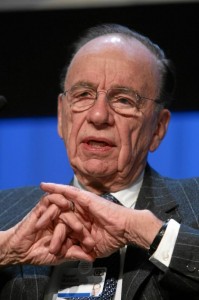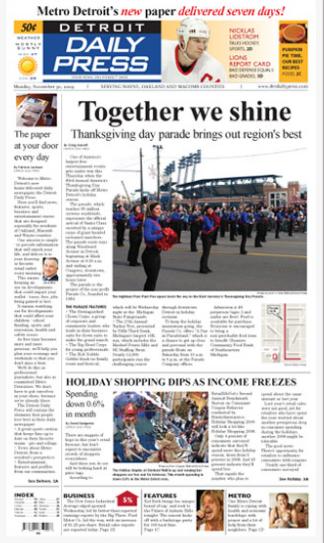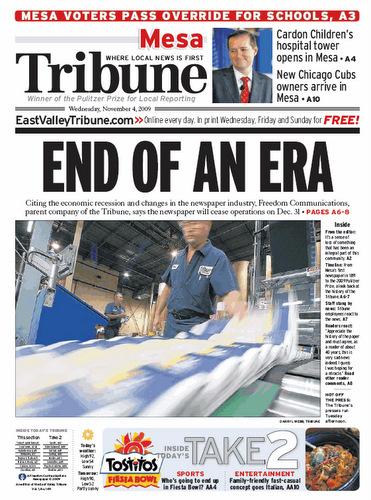 The Guardian’s Dan Kennedy has an intelligent piece about why the great newspaper collapse of 2009 didn’t pan out as expected. If you remember, early this year there were dramatic closures in major markets like Denver and Seattle, along with threats of similar harsh medicine in San Francisco and Boston. But as 2009 comes to a close, the San Francisco Chronicle and the Boston Globe are still alive and kicking and there have been no major newspaper shutdowns in nine months. Kennedy points out that publishers took strong action to reverse the tide after that scary first quarter, cutting back sharply on expenses, boosting subscription prices and finding novel new ways to generate revenue. They also had considerable success whittling down the debt that has paralyzed many of their operations
The Guardian’s Dan Kennedy has an intelligent piece about why the great newspaper collapse of 2009 didn’t pan out as expected. If you remember, early this year there were dramatic closures in major markets like Denver and Seattle, along with threats of similar harsh medicine in San Francisco and Boston. But as 2009 comes to a close, the San Francisco Chronicle and the Boston Globe are still alive and kicking and there have been no major newspaper shutdowns in nine months. Kennedy points out that publishers took strong action to reverse the tide after that scary first quarter, cutting back sharply on expenses, boosting subscription prices and finding novel new ways to generate revenue. They also had considerable success whittling down the debt that has paralyzed many of their operations
Most daily newspapers, in fact, operate in the black but massive debt accumulated during multiple rounds of consolidation earlier this decade were threatening their existence. The threat is still there, but it looks like there was more fat in newspaper operating budgets than many observers had believed. Washington Post publisher Katharine Weymouth has pointed out that her paper employs twice as many journalists as it did during the Watergate years, even after multiple rounds of cutbacks.
Time to celebrate? Hardly. This industry is not a growth story and probably never will be, but it does appear that publishers are finding ways to gracefully manage their print operations down to sustainable levels. Early experience indicates that online news publishers can the profitable at about 20% of the expense level of their print counterparts. It’s likely that some publishers will figure out ways to get there without shutting down the brand entirely. Of course the price of advertising is also in decline, but that’s a different problem entirely.
It turns out that shares a Gannett Corp. were a heckuva buy in March when they plummeted to $1.85. The stock hit $15.49 on Wednesday as a leading analyst upgraded his outlook for the newspaper industry, saying December could be the industry’s best month in three years. Well Fargo Securities analyst John Janedis said the slide in advertising is slowing and that ad revenues could be down only 8% or 9% next year, compared to more than 30% this year. Janedis raised his rating on Gannett to “outperform” from “underperform” and on New York Times Co. to “market Perform” from “underperform.”
Not in Our Back Yard
We continue to be amazed at how newspapers bury the lead when announcing bad news about themselves. Check out this press release from the Washington Times as reprinted on Talking Points Memo:
The Washington Times today announced that it will begin producing a more focused Monday through Friday edition designed to feature its most distinctive news and opinion content.
Offered as a combination controlled market and paid general interest newspaper at a price of $1.00, the new print edition will be available at retail outlets and newspaper boxes throughout the D.C. metropolitan area. The current newspaper’s last Sunday edition will publish on December 27.
That’s right: the news is that the Times is killing its Sunday edition. This is on top of laying off 40% of its staff a few weeks ago. The paper is also reportedly considering eliminating its sports section entirely. Perhaps the Times reporters wouldn’t bury the lead on this particular story, but the PR department surely did.
Miscellany
Slate’s Jack Shafer throws cold water on publishers’ love affair with e-readers. Citing slick recent demos by magazines like Sports Illustrated, Esquire, GQ and Wired of their content running on handheld tablets, Shafer harkens back to the days of the Washington Post‘s Pathfinder.com experiment and Newsweek on CD-ROM. Publishers thought those delivery vehicles were going to reinvent their business but the efforts crashed and burned for reasons ranging from the public apathy to the relentless commoditization of information. E-readers are simply another delivery device, Shafer asserts and the tiny sales generated by iPhone apps aren’t going to replace revenue lost from print advertising. The devices also negate the tactile and visual appeal of a print publication, reducing the editorial product to just another stream of content.
The New Bedford Standard-Times becomes the latest paper to start charging readers for online access. Its rather convoluted plan announced this week gives readers three stories per month for free, seven more stories if they register and full access for $4.60 per week. That package also includes a print subscription, which usually costs $4.23. So online access for existing readers comes at an additional charge of $.37 per week.
If you’re looking for an inspiring message to give journalism school students, you can’t do much better than the one NewsLab’s Deborah Potter invented for graduates of the University of North Carolina at Chapel Hill. Today’s journalism professionals need to be inquisitive, resourceful and versatile, she says. Yes, news organizations are contracting and pay levels are shrinking but journalists have an unprecedented opportunity to reach a global audience. You’re on your own more than you’ve ever been, but that can be energizing as much as it’s terrifying. The future of journalism is “what you DO, irrespective of where you do it…your credibility depends on HOW you do what you do, not where you do it.” Believe, us it reads better in context. Potter’s also confident that revenue models will emerge that make journalism sustainable.
If you’re wondering what all the fuss is about augmented reality, Jeff Jarvis has a nice collection of video clips showing different ways in which the commendation of images, databases and mobile access can make the world around us more accessible. Here’s one:







 After nearly losing its two daily newspapers a year ago,
After nearly losing its two daily newspapers a year ago,  Go to the basic
Go to the basic 




